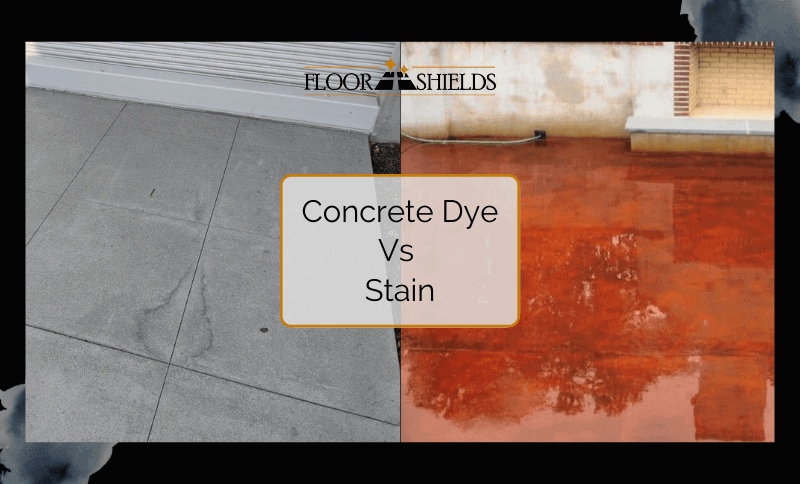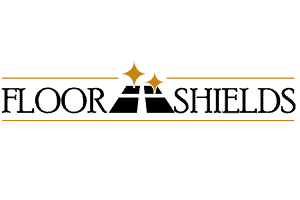
Concrete is a unique substance that is strong enough to build buildings.
It is also unbelievably absorbent, which means that stains and dyes bond to it, allowing you to turn boring concrete into almost any color you can imagine.
We’ve been staining concrete floors for over 15 years and researched to best DIY home concrete stains and dye’s.
There are different concrete stains and dyes for concrete that come in an array of different formulations. They run the gamut from water-based low VOC products to much harsher chemical-based solutions.
Concrete stains and dye’s are usually applied with a sprayer to give a solid and even color texture.
Concrete stains have different advantages and disadvantages that depend on the application and the artistic effects that you strive for on the concrete surfaces. In this article, we detail the different types of common concrete stains and dyes and several pros and cons based on decades of testing. We also go over a few tips for getting the best color results using stains and dyes.

Concrete Dye Vs Stain 10
Acid stains (Acid-based stains)
The stain starts a chemical reaction that reacts with the lime that is component of the concrete. The higher the lime content the deeper the color. This reaction makes the color permanent. A high quality sealer such as a solvent based acrylic or a urethane will bring deep color to the project and must be used to protect the bare concrete. One disadvantage of the acid stain is there are only eight color choices. Six of the colors are earth tones like tans, browns and blacks. Some manufacturers offer blue and green but unlike the earthy tones these two colors are not suitable for outdoor use. You might achieve many effects and colors if you dilute the acid stains, but the color palette is still generally limited to earthy tones. These chemical stains work as a great stain for exterior concrete surfaces (outdoor concrete)because the color will keep, as long as a sealer protects the surface.
Some tips worth noting
Remember to neutralize the surface after the concrete acid stains have finished reacting on the concrete. This can be done by adding 12 oz. of ammonia to each gallon of water and using a garden type water can to completely wet the floor. This application is absolutely necessary because ground moisture wicking up through the concrete could still cause the concrete stains to react again. This reaction will cause a hazy film that will be unsightly under the sealer.
Remove any stain residue that might create a barrier to the sealer’s penetration to form a film after its application. It is recommended to use a pressure washer on the exterior surfaces or thoroughly mop interior concrete.

Concrete Dye Vs Stain 11


Powdered acetone dyes
Many acetone-based concrete dyes in the market come in powdered form. These concrete dyes make an excellent choice for interior use after their application. There is a great array of colors available. However, the concrete dyes are not UV stable, and thus their application cannot be typically made on an outdoor concrete surface. They usually dry in a short time. This is different from acid concrete stains, which need a couple of hours to react. When used, concrete dyes can dry in seconds.
Some tips to note
These dyes are interior-only products. The dyes are not UV resistant. The profile of the concrete surface becomes quite important. For the (stains) dyes to bind or be absorbed into the concrete floor, the concrete surface pores need to be open. This can be achieved by grinding the surface.
If you prefer to etch the floor surface to open it up chemically, grinding is the way to go as muriatic acid and related product options will not give the surface a proper break down to give you good bond stains to produce the color as desired.
If you desire to polish your floors, powdered dye products are the products to use, as this is the only type of dye that will penetrate the pores, dyes concrete, and give the applied coloring.

Liquid acetone dyes
This isn’t a dye actually, but a thin, UV stable solvent stain with small enough pigments to penetrate the surface. They come in a wide range of color choices, like paint, unlike their non UV stable powder dyes counterparts. You can achieve a great range in color in a short amount of time. Similar to their powdered cousins, these dyes will dry quite quickly.

Some tips to note
If a contractor colors a surface with a liquid dye, you cannot polish it like you can with a powdered dye. Despite its great penetrating power into the concrete, it still leaves a small film on the surface that needs to be removed when the stained concrete is polished.

Water-based dyes
A water-based concrete stain is similar to paint that is designed to bond to the concrete. These Water-soluble dyes are available in many color options that are used by contractors in decorative concrete ideas. Water-soluble dyes are safe for contractors to use. These water-based dyes are a surface coating. This is because the pigments are too large to penetrate the concrete. However, this type of decorative concrete strain will give you a longer working time than dyes do. Water-based dyes give you greater control over the color.
Some tips to note
When water-based stains concrete is used, the concrete surface profile is usually quite important. These stains are more about bonding and less about pigments penetrating the concrete surface. It. Therefore, it needs to be rougher than when using the dyes (stains) to concentrate on enabling penetrating the dye pigments into the concrete surface.
These concrete stains will work well in outdoor settings since they are UV stable, and the penetrating pigments will provide vibrant colors. However, remember to reseal the concrete dyes regularly. This is because these things are like a sheet of plastic bonding to the surface. You will need to protect them.
It is only water-based stains and UV stable dyes that have white as an available color option. This is because of the actual particle that makes them white- Titanium is one of the too-large pigments to absorb into the concrete when applied.

Solvent-based dyes
A Solvent-based concrete stain is used primarily to tint solvent-based coatings. The solvent-based dyes can dry quickly if you apply them on concrete indoors, depending on what solvent dyes concrete is used. Using solvent-based stains with epoxies and urethanes on concrete is an easy way to create solid colors that will last and give a great look to the surface. This is especially so for industrial or other high-traffic floors.
Some tips to note
When using these dyes of concrete stains to tint coatings, it is essential to make sure that they are compatible with the coating’s chemical makeup.
Be careful when you use these concrete dyes to tint outdoor concrete coating. This is because the concrete dyes will be creating a bond with the coating rather than the concrete. The color will wear off if the coating does too. Once this happens, it is quite difficult to recoat and correct the stain colors in these spots. It is advisable to protect these outdoor color surfaces with a solvent-based sealer. Make sure to use a sealer every 2 to 3 years to keep the color.
Practice makes perfect
It is only with experience that you will know how to choose and apply the best stain or dye (product)for every project and properly combine them to achieve the desired look. You will learn how to use different options for stains and coatings to achieve the desired coloring. Whenever possible, it’s important to make a sample for each client to see the coloring results. When working with exterior projects, you might need to pour a separate slab to create your samples. While dealing with interior floors, you can always test in a closet. Clients are interested in seeing the process and results, give them a show. You can also follow us online and contact us on the same.
Something to remember
Unlike chemical staining agents, which react with cement particles, dyes do not react with concrete or other cement-based surfaces. The small dye particles are embedded in the pores of the concrete; therefore, many will not be removed.








